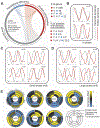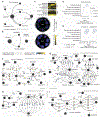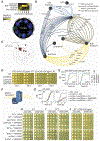Proteome-scale movements and compartment connectivity during the eukaryotic cell cycle
- PMID: 38452761
- PMCID: PMC10947830
- DOI: 10.1016/j.cell.2024.02.014
Proteome-scale movements and compartment connectivity during the eukaryotic cell cycle
Abstract
Cell cycle progression relies on coordinated changes in the composition and subcellular localization of the proteome. By applying two distinct convolutional neural networks on images of millions of live yeast cells, we resolved proteome-level dynamics in both concentration and localization during the cell cycle, with resolution of ∼20 subcellular localization classes. We show that a quarter of the proteome displays cell cycle periodicity, with proteins tending to be controlled either at the level of localization or concentration, but not both. Distinct levels of protein regulation are preferentially utilized for different aspects of the cell cycle, with changes in protein concentration being mostly involved in cell cycle control and changes in protein localization in the biophysical implementation of the cell cycle program. We present a resource for exploring global proteome dynamics during the cell cycle, which will aid in understanding a fundamental biological process at a systems level.
Keywords: Saccharomyces cerevisiae; automated image analysis; cell cycle; deep learning; differential scaling; high-content screening; protein localization; proteomics; spatiotemporal proteome; systems biology.
Copyright © 2024 The Author(s). Published by Elsevier Inc. All rights reserved.
Conflict of interest statement
Declaration of interests The authors declare no competing interests.
Figures






References
-
- Williams GH, and Stoeber K (2012). The cell cycle and cancer. J. Pathol 226, 352–364. - PubMed
-
- Crosby ME (2007). Cell Cycle: Principles of Control. Yale J. Biol. Med 80, 141.
MeSH terms
Substances
Grants and funding
LinkOut - more resources
Full Text Sources
Molecular Biology Databases

